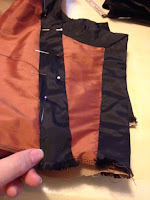Virtually everyone wore hose as they were called. They
are seen in nearly every manuscript out there. This is only one possible pattern or way to make hose.
Men wore hose that went up
the inside of the leg to the crotch and on the outside of the hip via a strap
and points (ties) to the waist. Men
could choose to wear the hose tied up or rolled down. A garter was secured either above the knee or
below the knee, the extra fabric was rolled down.
Women’s hose, which we will
be concentrating on today, were worn to either above or below the knee and
secured with a garter.
You will need approximately
1 yard of 54” muslin to make your pattern and the same amount for the actual
hose either of linen or wool fabric.
Measuring:
Below are reasonable renditions of the shape of the pattern pieces (not to scale).
1) Place your
foot on a piece of paper and trace around said foot. If your feet are the same
size, no worries, just flip your cut fashion fabric over for the other foot. Be
sure to trace straight down, keeping
your pencil perpendicular to your leg; do
not angle your pencil. Make a mark on each side of your foot, at the tall part
of your arch. This is where the vamp
will start and end on each side.
2) Measure
over the arch of your foot from side to side, from the high point of the arch
and to the end of the toes. You should
have half of an oblong shaped pattern. This
covers the vamp of the foot.
3) Measure
from the heel base up the back of the leg to the point where you want the top
of your hose to be. And around your
ankle and calf at it’s largest point.
OR:
1) As above.
2) Lay a bit of fabric over the arch of your foot and
trace from side to side and from toe to top of arch.
3) Wrap a bit of muslin around the calf and pin up the
back of the leg. Pin the fabric close. Using a marker, draw your seam line and
the line over the top of the foot where the vamp will be attached. After you
remove the fabric, and lay it flat, add ½ inch to allow for the seam allowance.
See Fig 2 and 3.
Please note that with either way, be sure to cut the leg
portion on the bias, not the grain of the fabric. This allows for a little
stretch in your hose around the calf of your leg.
Your final pattern should
take your hose to just over your knee, for room to roll them down or even
higher if you wish to garter your hose above your knee.
Sewing:
I like to sew the vamp to
the sole first. Pin and trim, then sew. Make sure to match the ends of your vamp
to the marks on the sole. After Fig. 1, It
looks like a little half slipper when you are done.
 Carefully pin the arch of
the vamp to the upside curve of the leg.
That is, the part of the fabric between the sides of the heel flaps.
Carefully pin the arch of
the vamp to the upside curve of the leg.
That is, the part of the fabric between the sides of the heel flaps.
Sew the leg to the vamp
first, then the sides of the leg to the sole, Fig 2. Then sew the back seam last, Fig 3.
Try your hose on, make any
adjustments necessary. For a little more comfort, trim any excess seam
allowance.
Hem your hose at the desired
height and enjoy. Since there is a left
and a right foot made on the hose, I like to add a little “L” or “R” to either
sock. Makes it easier for putting them
on!
Repeat with other leg.
**** Make your first sewn
pair of hose out of muslin, you may need to try several times to get your
pattern just right. Don’t give up.
Garter:
 |
| Gartered on |
 |
| Rolled over |
Garters could be leather,
ribbon or inkle trim. Buckles and leather (saddle ties) are available from Tandy
Leather in Costa Mesa or you can purchase pre-made period ones online.
Garters that we see on men
are leather and are fastened just below the knee. Ladies garters are
 |
| A Good fit |














